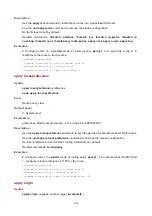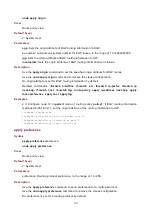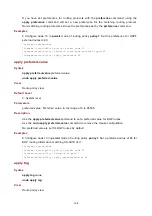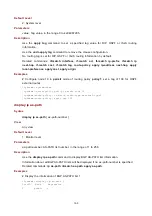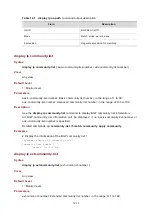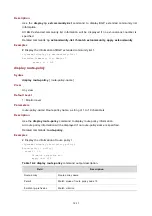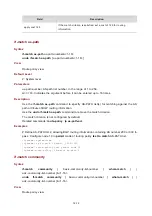
12-20
A route policy is used for routing information filtering or policy based routing. It contains several
nodes and each node comprises a set of if-match and apply clauses. The if-match clauses
define the matching criteria of the node and the apply clauses define the actions to be taken on
packets passing the node. The relation between the if-match clauses of a node is logic AND,
namely, all the if-match clauses must be satisfied. The relation between different route policy
nodes is logic OR, namely, a packet passing a node passes the route policy.
Related commands:
if-match interface
,
if-match acl
,
if-match ip-prefix
,
if-match ip
next-hop
,
if-match cost
,
if-match tag
,
apply ip-address next-hop
,
apply local-preference
,
apply cost
,
apply origin
,
apply tag
.
Examples
# Configure permit-mode node 10 of route policy
policy1
and enter route policy view.
<Sysname> system-view
[Sysname] route-policy policy1 permit node 10
[Sysname-route-policy]
IPv4 Route Policy Configuration Commands
apply fast-reroute
Syntax
apply
fast-reroute
backup-interface
interface-type interface-number
[
backup-nexthop
ip-address
]
undo apply fast-reroute
View
Route policy view
Default Level
2: System level
Parameters
backup-interface interface-type interface-number
: Specifies a backup outbound interface by
its type and number. If the specified backup outbound interface is a non-P2P interface (such as
a VLAN interface), you need to specify a backup next hop at the same time.
ip-address
: Backup next hop address.
Description
Use the
apply
fast-reroute
command to configure an FRR backup outbound interface and
backup next hop.
Use the
undo apply
fast-reroute
command to remove the configuration.
By default, no FRR backup outbound interface or backup next hop is configured.
When a link or a router in the network fails, the packets on the path may be discarded, or a
routing loop may occur. Then, the traffic will be interrupted until the routing protocol completes
routing convergence based on the new network topology.

